Abstract
Wetlands are important ecosystems with physical and economic benefits. However, many reports confirm the drastic loss of wetlands due to urbanisation and anthropogenic activities in many parts of the world. This study focused on the present-day state of wetlands in the Republic of South Africa. A meta-analysis was performed to elucidate the distribution and level of protection of selected wetlands. The classification of existing wetlands and the threat against wetlands were reported. Wetlands in South Africa are grossly endangered by human pollution, developmental activities, and invasive plants. From data obtained, about 47.89% of reported wetlands have a low level of protection and are thus susceptible to threats. The South African Department of Environmental Affairs protects most of the wetlands (28.17%) in the country. Major weaknesses identified for wetland degradation are the ignorance of people about the benefits of wetlands and the weak implementation of frameworks and policies that currently exist. The impact of legislations and policies on the preservation of wetlands is presented as well as the need for community education on environmental degradation. Therefore, the current state of several wetlands calls for urgent attention, and there is need for a strengthening of existing laws and policies in order to prevent wetland damage and extinction.
1. Introduction
A wetland is defined as an area of soil covered with water or has water close to its surface all year or at some periods of the year. They are necessary for people’s livelihoods but not usually considered important [1]. Wetlands are mostly found in humid regions and in moistened provinces [2], which implies that climatic conditions aid the occurrence of wetlands. They are categorised as marine, coastal, and inland systems [3]. Wetlands are characterised by the presence of hydrophytes, which can grow and reproduce in anaerobic soil conditions. Due to this, leaves and stems of wetland plants are often hollow and/or spongy [2].
Wetlands function for physical and economic benefits. The term “wetland value” connotes the direct benefit of the wetland, while “wetland function” is the indirect benefit. These benefits may include water storage, protection from storm, flood control and prevention, drought buffering, erosion control, groundwater recharge and discharge, shoreline stabilization, retention of nutrients, water purification, and stabilization of local climate conditions, especially temperature and rainfall [4]. Wetlands are economically important in the water supply [5,6,7]. The prominent need for water as a vital source of life and need for decontamination of water, as described by Adeeyo et al. [8], makes wetlands important since they also function for water treatment. They are capable of cleaning impurities from wastewater facilities and delivering purified water to the ecosystem [7]. Wetlands function for neutralising some contaminants, capturing sediment, and decontaminating water. Therefore, they can be regarded as natural filters. Wetlands have been reported to confer protection against weak storms and in states with relatively weak buildings. Additionally, they function for the enhancement of quality of water in water bodies. Furthermore, innumerable foods exist in wetlands, which tend to bring together uncountable animal species [9].
South Africa has been reported as a water-scarce country [10] due to characteristic low rainfall. Therefore, the water resources available have to be well-conserved to help with this problem of water scarcity. Wetlands have been reported to function for the purification of water and its treatment; hence they are useful in water conservation. In South Africa, wetlands cover a total of 29,000 km2, which is only about 2.4% of the entire land area [11], and there is need for the best management strategies to avoid extinction of the existing limited wetland resources [12]. Wetlands in South Africa are characterised by the availability of surface water and or underground water and the presence of hydric soils [13,14]. However, wetlands in South Africa, though limited, are still faced with the challenge of degradation. This degradation is leading to a reduction in the number of wetlands available and ultimately reducing the amount of quality and safe water available for use. Hence, South Africa was chosen as a case study for the reason of water scarcity. For wise utilisation of wetlands, South Africa decided to adopt the wetland policy from Ramsar (an international treaty for the conservation and sustainable use of wetlands, named after the city of Ramsar in Iran) in order to conserve and manage them wisely [12]. The distribution of notable Ramsar wetlands in South Africa is shown in Figure 1.
Although wetlands occur in nature, artificial wetlands exist that function just like natural wetlands and are created to reduce the pressure on natural ones. The underestimation of wetland benefits is expressed in their loss with about 64% being lost since 1990 [15]. The wetland ecosystem and its resources are under threat from human activities and global warming. Wetlands are impacted by anthropogenic activities such as agriculture, human settlement, mining, and others that alter the quality and quantity of water within the wetlands. Therefore, the conservation of available wetlands is of great necessity. A careful study of wetlands is necessary to help the conservation of this natural filter and will increase the amount of water available. Although there are fragments of literature discussing wetlands, these reports are independently focused on different aspects such as classification, pollution, and protection. However, this review is a comprehensive assemblage of these fragments about wetland resources in South Africa. This paper is expected to give answers to the question of the current state of wetland management in South Africa. It will also give insight into the strengths, weaknesses, opportunities, and solution strategies on wetland management in South Africa. Hence, this review aims to present the classification, importance, and types of wetlands and establish the present threats of South African wetlands as well as guidelines and legislation for management of wetlands in South Africa that will help to reiterate the need for conservation practices to prevent the extinction of these valuable ecosystems.
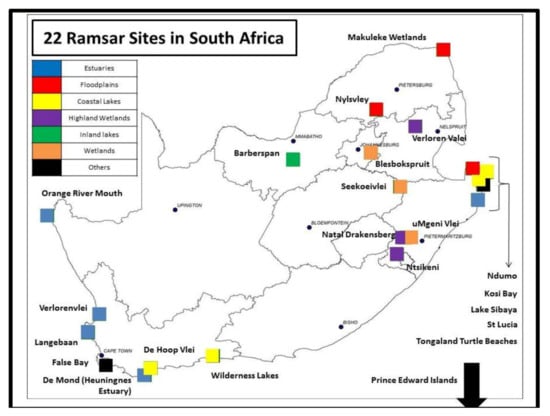
Figure 1.
Map indicating the 22 Ramsar sites in South Africa (Public Dataset [16]).
2. Methodology
South Africa is a water-scarce country, and since wetlands play an important role in watershed preservation, analysing the threats and providing solutions to wetland conservation may therefore be helpful for resource conservation. A total of 135 articles on wetlands were broadly reviewed for this study, and 77 articles were accepted based on their relevance to the study in South Africa. Fourteen articles were not used based on their old date of publication or repetition of information. A total of 63 articles were used in this review (Figure 2) The articles were sourced from Science Direct, Google Scholar, and EBSCO host databases. The Google search engine was also used to access grey literature, and many publications were found in government publications such as the South African Department of Environmental Affairs (DEA), South African Biodiversity Institute (SANBI), and the South African Water Research Commission. Keywords used in search of information include types of wetlands, benefits of wetlands, wetland threats in South Africa, South Africa’s policy for wetland management, and protection and wetland rehabilitation. Articles not directly giving information on the present state of wetlands in South Africa, function of wetlands and/or protection and management of wetlands were excluded in this review. Figures and tables are used for a better presentation of information.
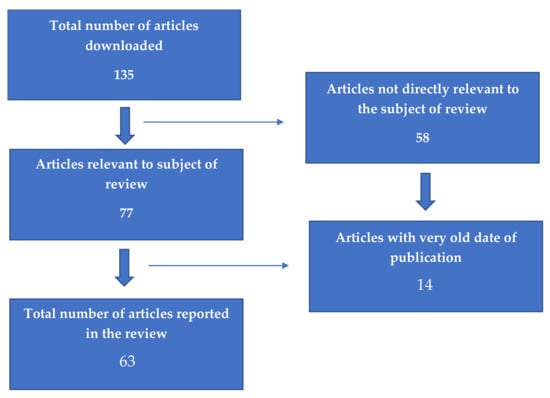
Figure 2.
Methodology for the selection and exclusion of source articles used in this review.
3. Wetlands and Their Classifications in South Africa
Wetlands are classified based on their biophysical properties such as plant species, soils, hydrology, animal types, function, and value [17]. Classification may be conducted for mapping, planning, acquisition, regulatory, and other purposes [18,19]. According to the Cowardin system, wetlands can be classified based on landscape, vegetation, and hydrologic regime as marine, tidal, lacustrine, palustrine, and riverine [3]. Based on their connectivity to open ocean, wetlands are classified as marine, estuary, and inland; however, there is a fourth category called artificial wetland, which is human-made but functions just as the natural types [10,20]. Figure 3 shows the classification of wetlands showing the different relationships among the different structures of classification.
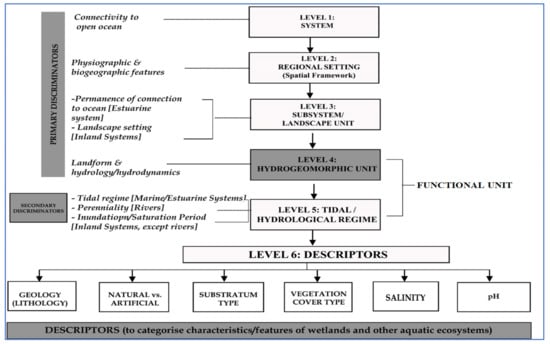
Figure 3.
Conceptual overview of classification system for wetlands and other aquatic ecosystems (With permission [21]).
The tiered structure moves from systems (marine vs. estuarine vs. inland) at the widest scale (Level 1), to regional and landscape units (Levels 2 and 3), and to hydrogeomorphic units as the finest spatial structure (Level 4). At Level 5, inland systems are separated based on the hydrological regime and, in the case of open water bodies, the inundation depth class. At Level 6, six ‘descriptors’ are used for the classification. These descriptors present a clear difference between the aquatic ecosystems with different structural, chemical, and/or biological characteristics [20].
3.1. Marine Wetlands
A marine system has been described to be the open sea part covering the continental shelf and/or its related shoreline and reaches up to 10 m at low tide [21]. Examples of marine/coastal wetlands are open coast, estuaries, tidal flats, coral reefs, mangrove forests, and coastal lagoons. In 2011, SANBI further classified marine and coastal habitats in South Africa into three, namely offshore, inshore, and coastal areas. The offshore areas consist of offshore pelagic and offshore benthic zones. The inshore zones include areas characterised by rocky or unconsolidated substrate. The third category, the coastal areas, is subdivided into rocky coast, mixed coast, and sandy coast. Marine wetlands are important habitats for fishes, dugongs, and marine turtles. Plants present include pig face, sea rush, marine couch, creeping bookweed, and swamp weed [22]. Based on wave exposure, geology, grain size, and/or beach state, the marine groups are classified into 14 categories [3]. These classifications alongside biogeographical differences (based on the delineation of marine “ecozones” and “ecoregions”) are used to regionalise the classes. This will result in a total of 136 marine and coastal habitats, 41 of which are shallow and less than 5 m in depth where marine and coastal wetlands tend to occur [20,23].
3.2. Estuarine Wetlands
Estuary wetlands are partially enclosed, and they contain water bodies that are always or sometimes open to the sea or on decadal timescales. Estuarine systems include estuarine bays, river mouths, estuarine lakes, permanently open estuaries, and temporarily open estuaries. Currently, the classification system for the estuary component of the 2011 National Biodiversity Assessment (NBA) was developed using different approaches considering the following four physical characteristics: estuary size, mouth state (permanently open or temporarily open/closed), salinity structure (fresh or mixed), and catchment type (turbid, black, or clear based on the colour of the inflowing river) [24]. The majority of the estuaries along the coast of South Africa have river catchments with conditions differing from those in adjacent marine inshore, that is, they are calm, sheltered, and shallow. They provide important nurseries for many species of marine fishes.
South Africa’s climate has a great effect on estuaries. They are affected by global warming characteristics such as rise in temperature, rainfall, sea level rise, storm disturbance, pH, and carbon dioxide [25]. This classification of features was presented together with the category of the biogeographical region to raise 46 estuarine ecosystem types for South Africa. The following estuarine habitats have been identified: water surface (estuary channel), rock, sand, and mudflats. The following plant communities have been identified including intertidal/subtidal macroalgal, submerged macrophytes, intertidal/supratidal saltmarsh, reed sand sedges, mangroves, and swamp forest [26]. The estuaries within South Africa with some level of protection are given in Table 1. A total of 84 fish species and 35 bird species are targeted for estuaries as presented by van Niekerk and Turpie [26]. The fish species include: Acanthopagrus berda, Ambasssis natalensis, Caranx papuensis, Elops machnata, Lichia amia, Liza alata, Pseudorhombus arsius, Solea bleekeri, Terapon jarbua, Syngnathus acus, and Valamguli seheli. The bird species include great white pelican, greater flamingo, grey plover, red knot, little stint, sanderling, swift tern, little tern, mangrove kingfisher, pink backed pelican, and squacco heron.

Table 1.
Some protected estuaries in South Africa.
3.3. Inland Wetlands
Inland systems are characteristically different from marine and coastal wetlands in that they are not connected to the ocean. Inland wetlands, examples of which are marshes and wet meadows, do not have a marine exchange and/or tidal influence [20,23]. These wetlands are dominated by herbaceous plants, while swamps are dominated by shrubs, and wooded swamps are dominated by trees [27]. Some of the Ramsar sites in South Africa along with their wetland types and location are presented in Table 2. Wetlands in KwaZulu-Natal are classified into three-level categories consisting of 16 wetland types based on the national wetland vegetation description [28]. These Ramsar sites are well-protected except Orange River Mouth in the Northern Cape and Verlorenvlei in the Western Cape, which are not formally protected [5]. Although wetlands are valuable, they are being lost due to impoundment, irrigation, hydroelectricity generation, food insecurity, population growth, and alien invasive biota [29].

Table 2.
Some Ramsar sites in South Africa.
4. Pollution and Threats to Wetlands in South Africa
In South Africa, floodplain wetlands are the most threatened and vulnerable wetland type. They are highly productive and accessible hence the ones mostly affected by anthropogenic activities such as agricultural and settlement purpose. Most of the wetlands drained are in cities where the development is very high as indicated in Figure 4. According to SANBI [5], 48% of wetland ecosystem types in South Africa are seriously and critically endangered by human activities. Wetlands in South Africa are being converted to residential areas and agricultural lands, and almost 50% of South African wetlands have declined for this reason. Approximately 300,000 wetlands remain in South Africa comprising 791 wetland ecosystem types of which 48% are critically endangered; 12% are endangered; 5% are susceptible to human activities, and 35% are least threatened. This means that wetlands in South Africa are greatly threatened.
About 11% of wetland ecosystem types in South Africa are protected, and the majority is conserved by Ramsar. Skowno et al. [7] reported that about 6% of inland ecosystem types are protected. Protected and preserved wetland ecosystem types in South Africa are found in protected areas (nature reserves/parks) in the eastern part of Mpumalanga (located in Kruger National Park), the Maputaland Coastal Plain in KwaZulu-Natal (within the iSimangaliso Wetland Park World Heritage Site) as well as parts of the Western Cape. Over 80% and 70% of the floodplain and valley bottom systems, respectively, are not protected.
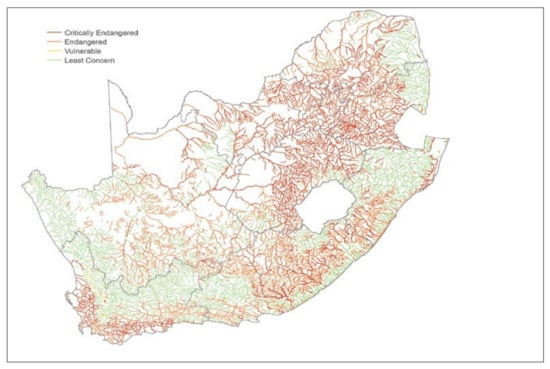
Figure 4.
Threat status of inland wetland ecosystems in South Africa (Public Dataset [7]).
4.1. Types of Pollutants in Wetlands
Air pollution from industrial activities and its impacts on wetlands have been reported in the literature [30]. Poorly treated sewerage discharge is one of the leading factors of pollution in wetlands and rivers in South Africa. The overpopulation of cities in South Africa has been identified as another problem leading to the development of unplanned informal settlements with major sources of pollution to aquatic ecosystem and wetlands in such areas [31]. The effects of such pollution on the marine ecosystem include dust and nutrient pollution as well as microplastic ingestion by wetland waterbirds [32]. Wetlands that received effluent from wastewater treatment plants and those associated with overpopulation were reported for a high content of microplastic pollutants [33]. In South Africa, coal dust from the Richards Bay terminal has been reported to contribute to pollution in the bay harbour and the surrounding environment. Coal dust pollution is usually associated with a reduction of photosynthetic performance of wetland plants [34]. Although pollution mitigation strategies are being implemented, such as spraying water and wind breaks that are aimed at minimising the effects of this type of pollution on the surrounding environment, these mitigations may not completely remove dust pollution effects in the wetlands. Mitigation strategies currently in place against such pollution therefore need to be improved.
The discharge of poorly treated sewage water into the environment is one of the leading factors of nutrient pollution in the wetlands and rivers in South Africa. A study conducted in the Rietvlei Nature Reserve wetland area showed that the pollution of the ecosystem was due to effluent discharge from the Hartbeesfontein sewage plant, an informal settlement and agricultural lands [35]. The overpopulation of cities in South Africa is a common problem as a large number of people are migrating from rural parts of the country in search of better economic opportunities to sustain them in cities. This situation has led to the rise of development of informal settlements, and since these residential areas were not planned for in terms of basic service provision and site location, they have become major sources of pollution in nearby land and aquatic ecosystems [31].
4.2. Wetland Ecosystem Threats
According to Daryadel and Talaei [36], wetlands are under threat from human activities. Several factors threaten the well-being and existence of wetlands; these factors include agricultural activities, mining activities, poor land management such as overgrazing, poor burning methods, the introduction of alien species, urban/infrastructure developments, and pollution discharged from different sites [36]. With no exception to South Africa, many wetlands have ceased to exist due to anthropogenic activities [37]. Some threats happen because of poverty and lack of sufficient knowledge about the value of wetlands. Indirect threats include increased population growth, poverty, unemployment, ignorance, and lack of wetland awareness [38].
4.3. Invasive Alien Threats
Invasive alien species pose a great threat to the wetland ecosystem and biodiversity. Examples of invasive alien species generally reported in wetlands are giant reed, water fern, water hyacinth, spear thistle, honey mesquite, purple vervain, common reed, and purple loosestrife [39]. In South Africa, water hyacinth, water fern, spear thistle, honey mesquite, and purple vervain are the top five wetland invaders [40]. Velvet mesquite has been reported for its impact on biodiversity, ground water supplies, rangeland productivity, and human livelihoods. Creeping bentgrass creates extensive clonal patches by means of long stolons that affect indigenous plants. Silver wattle, long-weaved wattle, and black wattle form closed canopy stands and uses excessive amounts of water [40]. These species are known to alter the overall components and operation of biodiversity in different ways, including hybridisation with native species and outcompeting the native species through predation and spreading of disease [41]. Invasive alien species compete with the native species, and in most cases, these invasive species tend to dominate native species. In some situations, this leads to the extinction of some native species of fish, amphibians, and plants in the area [41,42]. When alien trees and shrubs dominate areal biomass coverage, they increase evapotranspiration and limit wetlands and groundwater recharge [43]. The impact of alien plant invasion is associated with negative impacts on the ecosystem [44].
4.4. Human Developmental and Anthropogenic Threats
Urbanisation around the world is growing at an alarming rate. According to Kometa et al. [45], about 50% of the population lives in urban areas, which is a significant rise compared to 14% population that lived in urban areas at the beginning of 20th century. The increase in human population, development of rural areas, and rural to urban migration are some factors responsible for the rapid urbanisation in Africa [45]. Wetlands are naturally found in flat terrain, and these locations are normally preferable for urban development as these wetlands provide many benefits such as the availability of water and food that attract lots of human settlement and economic activities [46,47]. These benefits contribute to the loss of coastal and floodplain wetlands through drainage, mining of clay, and use of wetlands as agricultural farmlands [47]. With socioeconomic benefits being the target in urban development, some environmental aspects of wetland ecosystems that promote sustainability are often neglected. The study by Novoa et al. [48] to determine the effects of urbanisation on wetland ecosystems showed that urban wetlands are associated with high mud and turbidity. The study also showed that these wetlands had high concentrations of total bacteria as well as coliform as a result of illegal sewage discharge and faulty and leaky pipes in the sewage network.
4.5. Pollution Threats
Activities that are linked to human development and population expansion such as industrialisation, urbanisation, and expansion in the agricultural sector are some of the factors leading to the generation of pollutants that end up in wetlands and aquatic ecosystems around the world [49]. According to Govender-Ragubeer et al. [50], only a few wetlands in the Gauteng province in South Africa are left ecologically unharmed. Carpenter et al. [51] categorised the main sources of pollution in the aquatic ecosystem as either point source or nonpoint source.
Although wetlands serve as natural filters for polluted water, they can also become polluted by pesticide, sediment, sewage, and fertilizers thus degrading wetlands and water quality. Pollution in wetlands causes ecosystem degradation and species invasion. Pollutants are basically from household sewage, urban wastewater, garbage and solid waste, agricultural and forestry effluents, and industrial effluents. In all continents, 54% of wetlands are affected by pollution, making it the greatest threat, and North America is the highest continent reporting pollution of wetlands (61%) [52]. Pollutants of wetlands also affects surface water, underground water, and soil leading to worse water quality, parasite epidemics, and a lack of water [53]. Some major anthropogenic influences on the sustainability of wetlands in South Africa are shown in Figure 5.
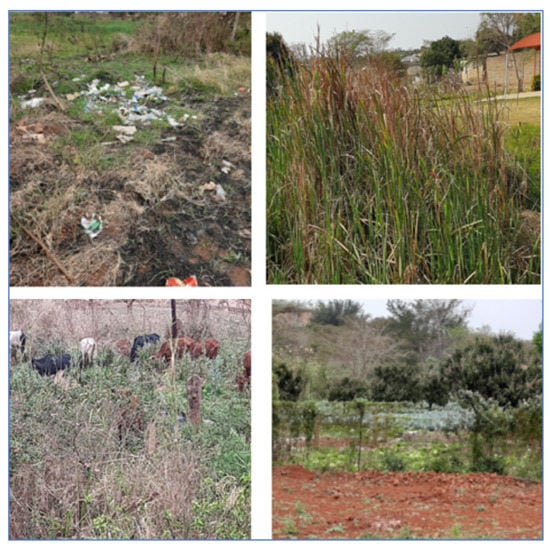
Figure 5.
Anthropogenic influences on wetlands. Left up shows the deposition of solid waste on the wetland; left down shows animals grazing on the wetland; right up shows building of residential buildings on the wetland; and right down shows planting of crops on the wetland.
5. Data and SWOT Analytical Study of Wetlands in South Africa
From Table 1, nine (9) protection agencies were identified; provincial, SANParks, municipal, CapeNature, EC Parks, DEA, DAFF, EKZNW, and the ISNP authority (Figure A1). DEA had the highest number of wetlands protected (28.17%). This is followed by SANParks and EC parks protecting 22.54% and 16.90% of the parks, respectively. About 9.86% of the wetlands are protected by municipal agencies and EKZNW each. The DEA and DAFF protect 4.23% of the wetlands, while provincial agencies and the ISNP Authority protect 1.41% of the wetlands each.
The levels of protection of the wetlands are classified as low, medium, medium/high, and high (Figure A2). It is expected that with a high level of protection, there will be fewer threats to the wetlands. About 47.89% of the wetlands have a low level of protection and will be more susceptible to threats. About 28.17% have medium protection; 1.41% have medium/high protection, and 22.54% have a high level of protection and are expected to be the least susceptible to threats. Inadequate protection is responsible for most threats reported (Table 3). Five (5) main types of wetlands were identified including estuary, floodplain, highland wetland, coastal lake, and inland lake (Table 2 and Figure A3). The Ramsar wetland site distribution indicates that Kwazulu-Natal has the highest wetland (35.3%), while Western Cape, Northern Cape, Northwest, and Mpumalanga have the lowest (5.9% each) (Figure A4).

Table 3.
SWOT analysis of wetlands in South Africa.
A SWOT analysis (Table 3) revealed the existence of a National Water Act that seeks to provide for the protection of water resources and the environment. Major weaknesses responsible for wetland degradation are the ignorance of people about the benefits of wetlands and the weak implementation of frameworks and policies that currently exist. Major opportunities identified include the interest of various governmental and nongovernmental organisations in the conservation of wetlands, while the threats include the need for land for different purposes as well as pollution from various anthropogenic activities.
6. Rehabilitating and Enhancing Wetland Function
The need to protect, preserve, conserve, and restore wetland ecosystems in South Africa is of prime importance for the biodiversity of both plants and animals together with the livelihoods of people and the aesthetic value of the country. There is huge loss and degradation of wetlands, and national policy and legislation provide clear direction and support for rehabilitation. However, rehabilitating wetlands is frequently complex because wetlands and their links with people are complex. Some national initiatives for wetland programmes aimed at aiding protection, rehabilitation, and use of wetlands in South Africa are: WET-management programmes: WET-roadmap, WET-origins, WET-management review, WET-outcome evaluate, WET-rehab plan, WET-prioritise, WET-legal, WET-health, WET-effective manage, WET-rehab methods, and WET-rehab evaluate, which are useful in the management of wetlands. WET-origins describes the remarkable geological and geomorphological processes that give rise to wetlands in South Africa. WET-management reviews are concerned about wetland rehabilitation, while WET-outcome evaluates the rehabilitation outcomes, and WET-rehab assesses the success of rehabilitation projects.
7. Guidelines Nexus Legislations, Policy and Institution Framework for Management of Wetlands in South Africa
The 1983 Conservation of Agricultural Resources Act was the most effective legal weapon for protecting South Africa’s wetlands outside protected areas prior to the emergence of the present environmental and water legislation. It is still in use today as a powerful legal weapon for managing wetland drainage, agriculture, and use of vegetation. The Act gives the Department of Agriculture, Fisheries, and Forestry (DAFF) a clear mandate in terms of wetland conservation and wise use, primarily to ensure the long-term viability of agricultural natural resources. The government’s environmental management policy [54] was created to give effect to constitutionally guaranteed rights to a healthy and safe environment that is preserved for the benefit of current and future generations.
The National Environmental Management Act of 1998 established a framework for respecting these rights and values. The Act emphasizes “sensitive, fragile, highly dynamic, or stressed ecosystems, such as coastal, estuaries, and similar systems,” requiring special attention in management and planning procedures. The National Environmental Management Act [55] has released a list of regulations for activities that may have major negative environmental consequences. The construction of aquaculture facilities, dams, canals, and infrastructure for water transfer, dredging, filling, and excavating in wetlands, and peat extraction are among the operations covered. The National Water Policy [56] and one of its statutory expressions, the 1998 National Water Act, are significant attempts to preserve wetlands from a policy perspective. These have been hailed as ground-breaking and forward-thinking for their explicit recognition that water resources are more than just water, that aquatic ecosystems are the resource base on which all other uses rely, and that healthy ecosystems underpin the long-term viability of water use [12]. Three sets of Resource Directed Measures are included in the Act to safeguard aquatic ecosystems and ensure ecologically sustainable development and use of water resources. South Africa, as a founding member of the Convention on Wetlands of International Importance, particularly as a waterfowl habitat, and because of its location on the southern tip of Africa, has a unique responsibility to lead international wetland conservation efforts through the management of transboundary resources such as water and wildlife in Southern Africa, as well as to encourage global wetland conservation.
Additionally, the importance of education on the preservation of wetlands cannot be disregarded as humans are expected to better respond to the need for environmental conservation when there is an understanding of how they contribute to its degradation. Using students as a case study, Erhabor and Don [57] reported that students who are environmentally aware and empowered allow for a long-term protection and stewardship of the environment. This presents the importance of environmental education. To achieve long-lasting effects against environmental problems, education and training must be regarded as being just as important as the enactment of regulations and policies. By raising awareness on environmental issues, people can better understand the role they play in the sustainability of the environment. Environmental education focuses on humanity’s relationship with the environment and its influence. This creates a link between human activities and natural and physical resources. It is critical to educate people about environmental challenges and enhance their ecological awareness in order to encourage behavioural changes [58].
8. Current Challenges and Limitations
Environmental law enforcement in South Africa has been entrusted to the Department of Environmental Affairs (DEA), South African National Parks (SAN Parks), iSimangaliso Wetland Park, all nine provincial environmental departments, four provincial conservation agencies, and a few municipalities. The National Emergency Management Agency (NEMA) and its subsidiary laws covering protected areas, biodiversity, waste, air quality, and coastal management are monitored and enforced by these member institutions. They share standard training, standard operating procedures, a logo, and a newsletter, as well as a national conference on environmental compliance and enforcement and quarterly meetings. They also submit data to the yearly National Environmental Compliance and Enforcement Report [56] in a uniform manner. Sections 31B and 31C of NEMA (as amended in 2005) allow the minister of the national DEA to appoint an Environmental Management Inspector (EMI). An official must complete any relevant training course approved by the Director-General to be eligible for the EMI designation. This course is currently known as the EMI Basic Training Course.
Despite the existence of cooperating institutions for wetland and resource protection, a lack of capacity and resources within national and provincial governments has resulted in challenges in implementing South African environmental law, despite the fact that it ranks among the best in the world [59]. Environmental regulations and criminal penalties alone are insufficient incentives to encourage long-term use. While criminal consequences can be intimidating, they have mostly failed to discourage polluters in South Africa, owing to the fact that fines for environmental damage are not high enough to deter polluters, and prosecutions are infrequent due to a lack of capacity and knowledge [60].
9. Conclusions and Recommendations
Wetlands cover only about 2.4% of the total area in South Africa. They are broadly classified into marine, coastal, and inland with differing connectivity to the ocean. Estuary, floodplain, highland wetland, coastal lake, bay, beach, island, and island lake are the types of wetlands in South Africa. Wetlands are located in Gauteng, Northern Cape, Northwest, Mpumalanga, Limpopo, Western Cape, and KwaZulu-Natal. Wetlands provide various benefits to the ecosystem while serving benefits to humans as well. However, wetlands in South Africa seem to be under pressure due to commercial agriculture, industrialisation, urbanisation, and other anthropogenic activities. The current status of wetlands considered to be of international importance in South Africa is either currently critically endangered, endangered, or under threat. This condition is influenced by pollution since most industries and wastewater treatments facilities discharge their effluents in waterways. For the maintenance and conservation of wetlands, South Africa has introduced policies and guidelines to protect these valuable resources, but enforcement of such guidelines is ineffective as most people are concerned with maximizing their need rather than preserving nature.
The following is hereby recommended:
- South Africa should introduce projects to teach the communities about sustainable use and the importance of wetlands where people should be taught about the indirect benefits of wetlands.
- The effluent discharge by industries and wastewater treatments facilities should be monitored and regulated.
- Existing and new personnel should be trained in environmental compliance monitoring and the application of laws, regulations, and policies with enough funding supplied.
- Continuous training for municipal staff members and other stakeholders should be provided.
- Enforcement of the laws and regulations on wetland management and conservation should be encouraged and done without prejudice.
Author Contributions
J.N.E., L.M.N., M.M. and S.S.N. conceptualised the study, A.O.A., J.N.E., L.M.N., M.M. and S.S.N. wrote the draft manuscript and A.O.A., M.A.A. and J.N.E. contributed immensely to the writing of the final manuscript. All authors have read and agreed to the published version of the manuscript.
Funding
This research was supported by a grant received from the Department of Science and Innovation (DSI) of South Africa administered via the Technology Innovation Agency (TIA).
Institutional Review Board Statement
Not applicable.
Informed Consent Statement
Not applicable.
Data Availability Statement
Publicly archived dataset and figures used are indicated in references [7,16].
Conflicts of Interest
The authors declare no conflict of interest.
Appendix A
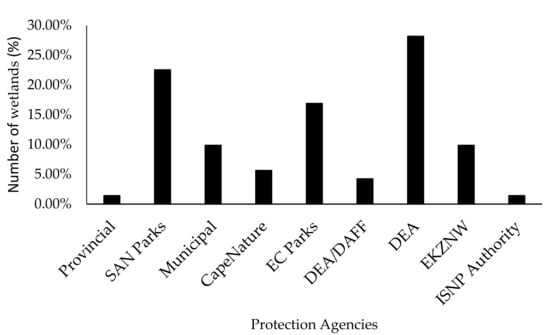
Figure A1.
The protection agencies for South African wetlands.
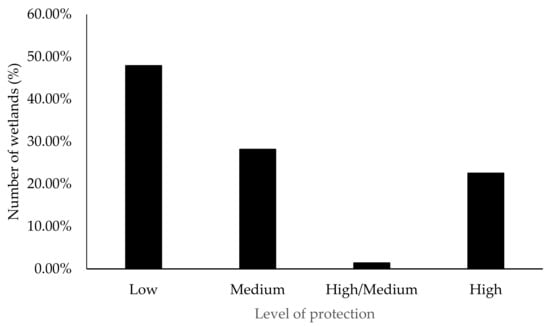
Figure A2.
The levels of protection of South African wetlands.
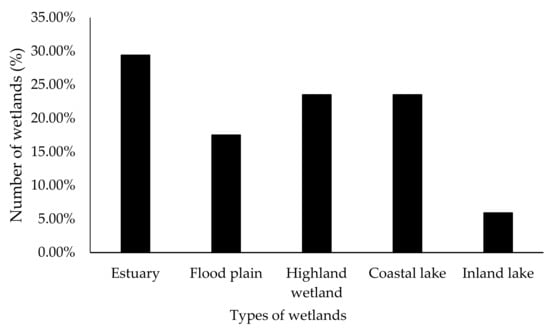
Figure A3.
Types of Ramsar wetlands.
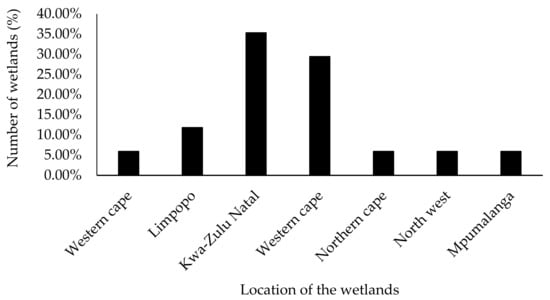
Figure A4.
Location of Ramsar wetlands.
References
- Russi, D.; ten Brink, P.; Farmer, A.; Badura, T.; Coates, D.; Forster, J.; Kumar, R.; Davidson, N. The Economics of Ecosystems and Biodiversity for Water and Wetlands; IEEP: London, UK; Brussels, Belgium; Ramsar Secretariat: Gland, Switzerland, 2013. [Google Scholar]
- Eco-Pulse. ICLEI Wetland Management Guidelines—Building Capacity and Supporting Effective Management of Wetlands within South African Municipalities, 3rd ed.; Preliminary Version; Eco-Pulse: Hilton, South Africa, 2018. [Google Scholar]
- United Nations Environmental Protection Agency. Classification and Types of Wetland. Available online: https://www.epa.gov/wetlands/classification-and-types-wetlands#undefined (accessed on 11 December 2021).
- Rafiq, R.; Alam, S.; Rahman, M.; Islam, I. Conserving wetlands: Valuation of indirect use of benefits of a wetland of Dhaka. Inter. J. Environ. Sci. Dev. 2013, 5, 64–69. [Google Scholar]
- Von Staden, L. Planning for Improved Threatened Species Conservation. SANBI 2013. Available online: http://opus.sanbi.org/bitstream/20.500.12143/7278/1/BPF2013_Planning%20for%20improved%20threatened%20species%20conservation_Von%20Staden.pdf (accessed on 11 December 2021).
- Nemutamvuni, K. Multi-Stakeholder Management of a Wetland in the City of Tshwane: The Case of Colbyn. Ph.D. Thesis, University of South Africa, Pretoria, South Africa, 2018. [Google Scholar]
- Skowno, A.L.; Poole, C.J.; Raimondo, D.C.; Sink, K.J.; Van Deventer, H.; Van Niekerk, L.; Harris, L.R.; SmithAdao, L.B.; Tolley, K.A.; Zengeya, T.A.; et al. National Biodiversity Assessment 2018: The Status of South Africa’s Ecosystems and Biodiversity; Synthesis Report; South African National Biodiversity Institute: Pretoria, South Africa, 2019; pp. 1–214. [Google Scholar]
- Adeeyo, A.O.; Odelade, K.A.; Msagati, T.A.M.; Odiyo, J.O. Antimicrobial potencies of selected native African herbs against water microbes. J. King Saud Univ. Sci. 2020, 32, 2349–2357. [Google Scholar] [CrossRef]
- U.S. Environmental Protection Agency. Distance Learning Models on Watershed Management. Available online: http://www.epa.gov/watertrain (accessed on 11 December 2021).
- Ollis, D.J.; Jennifer, A.D.; Mbona, N.; Dini, J.A. South African Wetlands: Classification of Ecosystem Types. In The Wetland Book; Springer: Berlin/Heidelberg, Germany, 2016; pp. 1–13. [Google Scholar]
- Dini, J.; Everard, M. National Wetland Policy: South Africa. In The Wetland Book; Springer: Berlin/Heidelberg, Germany, 2016; pp. 1–6. [Google Scholar]
- Department of Environmental Affairs. What You Should Know about South Africa’s Wetlands; Ramsar Convention on Wetlands: Ramsar, Iran, 2018. [Google Scholar]
- Braack, A.M.; Walters, D.; Kotze, D.C. Practical Wetland Management. In South Africa: Rennies Wetlands Project; Ecosystem Marketplace: Washington, DC, USA, 2000. [Google Scholar]
- Sakana, N.; Alvarez, M.; Boehme, B.; Handa, C.; Wangechi, H.; Langensiepen, M.; Menz, G.; Misana, S.; Mogha, N.; Moseler, B.M.; et al. Classification, characterisation and use of small wetlands in East Africa. Wetlands 2011, 31, 1103–1116. [Google Scholar] [CrossRef]
- Ramsar Convention on Wetlands. Wetlands: A Global Disappearing Act; Fact Sheet 3.1; Ramsar Convention on Wetlands: Ramsar, Iran, 2015. [Google Scholar]
- Kock, A. Diatom Diversity and Response to Water Quality within the Makuleke Wetlands and Lake Sibaya. Master’s Dissertation, Potchefstroom Campus of the North-West University, Potchefstroom, South Africa, 2017. [Google Scholar]
- Ewart-Smith, J.L.; Ollis, D.J.; Day, J.A.; Malan, H.L. National Wetland Inventory: Development of a Wetland Classification System for South Africa; WRC Report No. KV 174/06; Water Research Commission: Pretoria, South Africa, 2006. [Google Scholar]
- Ollis, D.; Snaddon, K.; Job, N.; Mbona, N. Classification System for Wetlands and Other Aquatic Ecosystems in South Africa; SANBI: Cape Town, South Africa, 2013. [Google Scholar]
- Ellery, W.N.; Grenfell, S.E.; Grenfell, M.C.; Powell, R.; Kotze, D.C.; Marren, P.M.; Knight, J. Wetlands in Southern Africa; Cambridge University Press: Cambridge, UK, 2016. [Google Scholar]
- Makopondo, R.O.B.; Rotich, L.; Kamau, C.G. Potential use and challenges of constructed wetlands for wastewater treatment and conservation in game lodges and resorts in Kenya. Sci. World J. 2020, 2, e9184192. [Google Scholar] [CrossRef] [PubMed]
- Ollis, D.J.; Ewart-Smith, J.L.; Day, J.A.; Job, N.M.; Macfarlane, D.M.; Snaddon, C.D.; Sieben, E.J.J.; Dini, J.A.; Mbona, N. The development of a classification system for inland aquatic ecosystems in South Africa. Water SA 2015, 41, 727–745. [Google Scholar] [CrossRef]
- NSW Department of Planning. Industry and Environment. Available online: https://www.environment.nsw.gov.au/topics/water/wetlands/plants-and-animals-in-wetlands/plants (accessed on 27 July 2021).
- SANBI. The South African National Biodiversity Institute Is Thanked for the Use of Data from the National Herbarium; Pretoria (PRE) Computerized Information System (PRECIS): Pretoria, South Africa, 2009. [Google Scholar]
- Van Niekerk, L.; Turpie, J.K. South African National Biodiversity Asessment 2011; Technical Report: Volume 3: Estuary Component. CSIR Report Number CSIR/NRE/ECOS/ER/2011/0045/B; CSIR: Stellenbosch, South Africa, 2012. [Google Scholar]
- James, N.C.; Niekerk, L.V.; Whitfiled, A.K.; Potts, W.M.; Gotz, A.; Paterson, A.W. Effects of climate change on South African estuaries and associated fish species. Clim. Res. 2013, 57, 233–248. [Google Scholar] [CrossRef]
- van Niekerk, L.; Adams, J.B.; James, N.C.; Lamberth, S.J.; MacKay, C.F.; Turpie, J.K.; Rajkaran, A.; Weerts, S.P.; Whitfield, A.K. An estuary ecosystem classification that encompasses biogeography and a high diversity of types in support of protection and management. Afr. J. Aquat. Sci. 2020, 45, 199–216. [Google Scholar] [CrossRef]
- EPA. What Is a Wetland? Available online: https://www.epa.gov/wetlands/what-wetland (accessed on 27 July 2021).
- Rivers-Moore, N.A.; Goodman, P.S. River and wetland classifications for freshwater conservation planning in KwaZulu Natal, South Africa. Afr. J. Aquat. Sci. 2010, 35, 61–72. [Google Scholar] [CrossRef]
- Mitchell, S.A. The status of wetlands, threats and the predicted effect of global climate change: The situation in Sub Sahara Africa. Aquat. Sci. 2013, 75, 95–112. [Google Scholar] [CrossRef]
- Robins, T.G.; Batterman, S.; Mentz, G.B.; Kistnasamy, B.; Jack, C.; Irusen, E.; Lalloo, U.; Naidoo, R.; Baijnath, N.; Amsterdam, H. Respiratory health and air pollution in South Durban: The settlers school study. Epidemiology 2005, 16, S79. [Google Scholar] [CrossRef]
- Mlambo, V. An overview of rural-urban migration in South Africa: Its causes and implications. Arch. Bus. Res. 2018, 6, 63–70. [Google Scholar] [CrossRef]
- Bergmann, M.; Gutow, L.; Klages, M. Marine Anthropogenic Litter; Springer Nature: Berlin/Heidelberg, Germany, 2015; p. 447. [Google Scholar]
- Reynolds, C.; Ryan, P.G. Micro-plastic ingestion by waterbirds from contaminated wetlands in South Africa. Mar. Pollut. Bull. 2018, 126, 330–333. [Google Scholar] [CrossRef]
- Naidoo, G.; Chirkoot, D. The effects of coal dust on photosynthetic performance of the mangrove, Avicennia marina in Richards Bay, South Africa. Environ. Pollut. 2004, 127, 359–366. [Google Scholar] [CrossRef]
- Oberholster, P.J.; Botha, A.M.; Cloete, T.E. Biological and chemical evaluation of sewage water pollution in the Rietvlei nature reserve wetland area, South Africa. Environ. Pollut. 2008, 156, 184–192. [Google Scholar] [CrossRef]
- Daryadel, E.; Talaei, F. Analytical study on threats to wetland ecosystems and their solutions in the Framework of the Ramsar Convention. World Acad. Sci. Eng. Technol. 2014, 8, 2091–2101. [Google Scholar]
- Nemutamvuni, K.; McKay, T.J.M.; Tantoh, H.B. Active citizenry, Community–Based organisations and the protection of urban wetlands: The case of Colbyn, Tshwane, South Africa. Glob. Ecol. Conserv. 2020, 24, 1244. [Google Scholar] [CrossRef]
- Swanepoel, C.M.; Barnard, R.O. Wetlands in Agriculture. Pretoria, South Africa; Water Research Commission: Pretoria, South Africa, 2007; pp. 1–49. [Google Scholar]
- Solitude Lake Management. How to Control Invasive Wetland Plants, Phragmites and Purple Loosestrife. Available online: https://www.solitudelakemanagement.com/blog/wetland-invasive-species-management-controlling-phragmites-purple-loosestrife/ (accessed on 27 July 2021).
- AgriOrbit. Invasive Alien Plants and Their Impact on Wetlands. Available online: https://www.agriorbit.com/invasive-alien-plants-and-their-impact-on-wetlands/# (accessed on 27 July 2020).
- Zengeya, T.A.; Kumschick, S.; Weyl, O.L.; van Wilgen, B.W. An Evaluation of the Impacts of Alien Species on Biodiversity in South Africa Using Different Assessment Methods. In Biological Invasions in South Africa; Springer: Cham, Switzerland, 2020; pp. 489–512. [Google Scholar]
- Davis, M.A. Biotic globalization: Does competition from introduced species threaten biodiversity? Bioscience 2003, 53, 481–489. [Google Scholar] [CrossRef]
- Gaertner, M.; Den Breeyen, A.; Hui, C.; Richardson, D.M. Impacts of alien plant invasions on species richness in Mediterranean-type ecosystems: A meta-analysis. Prog. Phys. Geogr. 2009, 33, 319–338. [Google Scholar] [CrossRef]
- Davies, K.F.; Chesson, P.; Harrison, S.; Inouye, B.D.; Melbourne, B.A.; Rice, K.J. Spatial heterogeneity explains the scale dependence of the native—Exotic diversity relationship. Ecology 2005, 86, 1602–1610. [Google Scholar] [CrossRef]
- Kometa, S.S.; Kimengsi, J.N.; Petiangma, D.M. Urban development and its implications on wetland ecosystem services in Ndop, Cameroon. Environ. Manag. Sustain. Dev. 2017, 7, 21. [Google Scholar] [CrossRef][Green Version]
- Zedler, J.B.; Leach, M.K. Managing urban wetlands for multiple use: Research, restoration, and recreation. Urban Ecosyst. 1998, 2, 189–204. [Google Scholar] [CrossRef]
- Nabahungu, N.L.; Visser, S.M. Farmers’ knowledge and perception of agricultural wetland management in Rwanda. Land Degrad. Dev. 2013, 24, 363–374. [Google Scholar] [CrossRef]
- Novoa, V.; Rojas, O.; Ahumada-Rudolph, R.; Sáez, K.; Fierro, P.; Rojas, C. Coastal wetlands: Ecosystems affected by urbanization? Water 2020, 12, 698. [Google Scholar] [CrossRef]
- Xiaolong, W.; Jingyi, H.; Ligang, X.; Qi, Z. Spatial and seasonal variations of the contamination within water body of the Grand Canal, China. Environ. Pollut. 2010, 158, 1513–1520. [Google Scholar] [CrossRef]
- Govender-Ragubeer, Y.; Meeuwis, J.; McKay, T.M. A series of unfortunate events: How the battle to save an urban wetland was both won and lost. TD J. Transdiscipl. Res. S. Afr. 2014, 10, 149–168. [Google Scholar] [CrossRef]
- Carpenter, S.R.; Caraco, N.F.; Correll, D.L.; Howarth, R.W.; Sharpley, A.N.; Smith, V.H. Nonpoint pollution of surface waters with phosphorus and nitrogen. Ecol. Appl. 1998, 8, 559–568. [Google Scholar] [CrossRef]
- Xu, T.; Weng, B.; Yan, D.; Wang, K.; Li, X.; Bi, W.; Li, M.; Cheng, X.; Liu, Y. Wetlands of international importance: Status, threats and future protection. Int. J. Environ. Res. Public Health 2019, 16, 1818. [Google Scholar] [CrossRef]
- Hushulong, Q. The problem of wetlands in our country and the researches. Energy Proc. 2012, 17, 462–466. [Google Scholar] [CrossRef][Green Version]
- DEAT. White Paper on Environmental Management Policy for South Africa; Government Gazette No. 18894. Notice No. 749; Ministry of Environmental Affairs and Tourism: Pretoria, South Africa, 1998. [Google Scholar]
- DEA. National Environmental Management Act (107/1998): Environmental Impact Assessment Regulations; Government Gazette No. 33306. Notices R543–546; Ministry of Environmental Affairs and Tourism: Pretoria, South Africa, 2010. [Google Scholar]
- National Environment Management Authority. Strategy and Planning; NEMA’s Annual Corporate Reports FY2013/14; National Environment Management Authority: Nairobi, Kenya, 2014; Available online: http://nema.go.ug/content/strategy-and-planning-nema%E2%80%99s-annual-corporate-report-fy201314 (accessed on 28 July 2021).
- Erhabor, N.I.; Don, J.U. Impact of environmental education on the knowledge and attitude of students towards the environment. Int. J. Environ. Sci. Educ. 2016, 11, 5367–5375. [Google Scholar] [CrossRef][Green Version]
- Erkal, S.; Gursoy, N. Importance of environmental education to achievement of sustainable development. AWER Procedia Adv. Appl. Sci. 2013, 1, 1042–1045. [Google Scholar]
- Paterson, A.R. Legal Framework for Protected Areas in South Africa; IUCN-EPLP, No. 81; University of Cape Town: Cape Town, South Africa, 2009; pp. 1–47. [Google Scholar]
- Hugo, R.E. Administrative Penalties as a Tool for Resolving South Africa’s Environmental Compliance and Enforcement Woes. Master’s Thesis, University of Cape Town, Cape Town, South Africa, 2014; pp. 53–76. [Google Scholar]
Publisher’s Note: MDPI stays neutral with regard to jurisdictional claims in published maps and institutional affiliations. |
© 2022 by the authors. Licensee MDPI, Basel, Switzerland. This article is an open access article distributed under the terms and conditions of the Creative Commons Attribution (CC BY) license (https://creativecommons.org/licenses/by/4.0/).